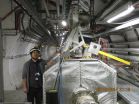(Press-News.org) Sea level rise poses one of the biggest threats to human systems in a globally warming world, potentially causing trillions of dollars' worth of damages to flooded cities around the world. As surface temperatures rise, ice sheets are melting at record rates and sea levels are rising.
But there may be some good news amid the worry. Sea levels may not rise as high as assumed.
To predict sea level changes, scientists look to Earth's distant past, when climate conditions were similar to today, and investigate how the planet's ice sheets responded then to warmer temperatures brought on by increased carbon dioxide in the atmosphere.
In a recently published study in the journal Geology, PhD students Matthew Winnick and Jeremy Caves at Stanford School of Earth, Energy & Environmental Sciences explored these very old conditions and found that sea level might not have risen as much as previously thought - and thus may not rise as fast as predicted now.
To better understand global sea level rise, Winnick and Caves analyzed the middle Pliocene warm period, the last time in Earth's history, approximately 3 million years ago, when carbon dioxide levels in the atmosphere were close to their present values (350-450 parts per million).
"The Pliocene is an important analogue for today's planet not only because of the related greenhouse gas concentrations, but because the continents were roughly where they are today, meaning ocean and climate circulation patterns are comparable," said Winnick.
These similarities are why the Intergovernmental Panel on Climate Change (IPCC), the group responsible for global sea level rise projections, focuses on the mid-Pliocene warm period to inform their computer models.
Previous studies of the mid-Pliocene warm period used oxygen isotope records to determine the volume of Earth's ice sheets and, by proxy, sea level. Effectively, the oxygen isotope records act as a fingerprint of Earth's ice sheets. By combining the fingerprint with models of ice sheet meltwater, many previous researchers thought that sea level was likely 82 to 98 feet (25 to 30 meters) higher during the Pliocene.
Such high sea level would require a full deglaciation of the Greenland Ice Sheet and the West Antarctic Ice Sheet, and as much as 30 percent of the East Antarctic Ice Sheet - enough to cover New York City under 50 feet of water. But these estimates arose because the researchers assumed that the Antarctic ice of the Pliocene had the same isotopic composition, that is, the same fingerprint, as it does today - an assumption that Winnick and Caves challenge in their new report.
To understand the isotopic composition of Pliocene ice, Winnick and Caves began in the present day using well-established relationships between temperature and the geochemical fingerprint. By combining this modern relationship with estimates of ancient Pliocene surface temperatures, they were able to better refine the fingerprint of the Antarctic ice millions of years ago. In re-thinking this critical assumption, and by extending their analysis to incorporate ice sheet models, Winnick and Caves recalculated the global sea level of the Pliocene and found that it was 30 to 44 feet (9 to 13.5 meters) higher, significantly lower than the previous estimate.
"Our results are tentatively good news," Winnick said. "They suggest that global sea level is less sensitive to high atmospheric carbon dioxide concentrations than previously thought. In particular, we argue that this is due to the stability of the East Antarctic Ice Sheet, which might be more resilient than previous studies have suggested." However, a rise in global sea level by up to 44 feet (13.5 meters) is still enough to inundate Miami, New Orleans and New York City, and threaten large portions of San Francisco, Winnick cautioned.
While the study helps refine our understanding of Pliocene sea level, both Winnick and Caves point out that it's not straightforward to apply these results to today's planet. "Ice sheets typically take centuries to millennia to respond to increased carbon dioxide, so it's more difficult to say what will happen on shorter time scales, like the next few decades," Winnick said.
"Add that to the fact that CO2 levels were relatively consistent in the Pliocene, and we're increasing them much more rapidly today, and it really highlights the importance of understanding how sea level responds to rising temperatures. Estimates of Pliocene sea level might provide a powerful tool for testing the ability of our ice sheet models to predict future changes in sea level."
INFORMATION:
High blood sugar is a defining characteristic of Type 2 diabetes and the cause of many of the condition's complications, including kidney failure, heart disease, and blindness. Most diabetes medications aim to maintain normal blood sugar (glucose) levels and prevent high blood sugar by controlling insulin.
A new University of Iowa study shows that another biological checkpoint, known as the Mitochondrial Pyruvate Carrier (MPC), is critical for controlling glucose production in the liver and could potentially be a new target for drugs to treat diabetes.
The study, led ...
LAWRENCE -- Researchers at the University of Kansas working with an international team at the Large Hadron Collider have produced quark-gluon plasma -- a state of matter thought to have existed right at the birth of the universe -- with fewer particles than previously thought possible.
The material was discovered by colliding protons with lead nuclei at high energy inside the supercollider's Compact Muon Solenoid detector. Physicists have dubbed the resulting plasma the "littlest liquid."
"Before the CMS experimental results, it had been thought the medium created in ...
DARIEN, IL - A new study shows that high school students lose sleep on school nights following the change to daylight saving time that occurs in March. The loss of sleep during the school week was associated with a decline in vigilance and cognitive function, which raises safety concerns for teen drivers.
Results show that the average objectively measured sleep duration on the weeknights after the spring time change declined to 7 hours, 19 minutes, which reflects a mean loss of 32 minutes per night compared with the school week prior to the implementation of daylight ...
MADISON, Wis. - Orchids, a fantastically complicated and diverse group of flowering plants, have long blended the exotic with the beautiful. Most species live on trees, often in remote, tropical mountains. Their flowers can be strange -- one even flowers underground, and many species deceive their pollinators into thinking they are good to eat.
Some are florist's staples, like phalaenopsis, the hot-pink and white flower that is easy to grow and easier to sell. Beyond the "job" of looking beautiful, only the vanilla orchids have any commercial role.
The estimated ...
Repeated exposure to anesthesia early in life causes alterations in emotional behavior that may persist long-term, according to a study from the Icahn School of Medicine at Mount Sinai in collaboration with the Yerkes National Primate Research Center, and published in the Online First edition of Anesthesiology, the official medical journal of the American Society of Anesthesiologists®.
Each year, approximately one million children under the age of four undergo surgery with general anesthesia, according to the U.S. Food and Drug Administration (FDA). Retrospective ...
A study that used stored blood samples from U.S. Air Force personnel who conducted aerial herbicide spray missions of Agent Orange during the Vietnam war found a more than 2-fold increased risk of the precursor to multiple myeloma known as monoclonal gammopathy of undetermined significance (MGUS), according to an article published online by JAMA Oncology.
While the cause of MGUS and multiple myeloma (plasma cell cancer) remains largely unclear, studies have reported an elevated risk of multiple myeloma among farmers and other agricultural workers and pesticides have ...
CAMBRIDGE, Mass. -- The technology behind 3-D printing is growing more and more common, but the ability to create designs for it is not. Any but the simplest designs require expertise with computer-aided design (CAD) applications, and even for the experts, the design process is immensely time consuming.
Researchers at MIT and the Interdisciplinary Center Herzliya in Israel aim to change that, with a new system that automatically turns CAD files into visual models that users can modify in real time, simply by moving virtual sliders on a Web page. Once the design meets ...
CAMBRIDGE, Mass. (September 3, 2015) - In the breast, cancer stem cells and normal stem cells can arise from different cell types but tap into distinct yet related stem cell programs, according to Whitehead Institute researchers. The differences between these stem cell programs may be significant enough to be exploited by future therapeutics.
Deadly tumor-initiating cells seed metastases throughout the body and cause relapses in patients. Whether these tumor-initiating cells can also be referred to as stem cells, specifically, cancer stem cells, has been up for debate. ...
A brief series of classes to help first-time parents better support each other through the often stressful transition to parenthood has a positive effect on birth outcomes as well, according to health researchers.
A decade ago Mark Feinberg, research professor at the Bennett Pierce Prevention Research Center for the Promotion of Human Development, Penn State, developed Family Foundations, a series of classes for expectant parents. In two research trials, the program was shown to improve the way parents support each other -- to reduce parental stress, depression and anxiety; ...
AUSTIN, Texas -- Evidence from the tropical lowlands of Central America reveals how Maya activity more than 2,000 years ago not only contributed to the decline of their environment but continues to influence today's environmental conditions, according to researchers at The University of Texas at Austin.
Synthesizing old and new data, researchers were the first to show the full extent of the "Mayacene" as a microcosm of the early anthropocene -- a period when human activity began greatly affecting environmental conditions.
"Most popular sources talk about the anthropocene ...


